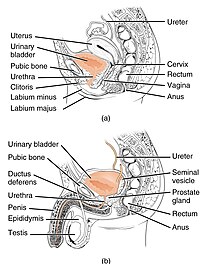
Photo from wikipedia
BackgroundWe review our outcomes and experience of artificial urinary sphincter implantation for patients with refractory urinary incontinence from different causes.MethodsBetween April 2002 and May 2017, a total of 32 patients… Click to show full abstract
BackgroundWe review our outcomes and experience of artificial urinary sphincter implantation for patients with refractory urinary incontinence from different causes.MethodsBetween April 2002 and May 2017, a total of 32 patients (median age, 40.8 years) with urinary incontinence had undergone artificial urinary sphincter placement during urinary tract reconstruction. Eighteen patients (56.3%) were urethral injuries associated urinary incontinence, 9 (28.1%) had neurogenic urinary incontinence and 5 (15.6%) were post-prostatectomy incontinence. Necessary surgeries were conducted before artificial urinary sphincter placement as staged procedures, including urethral strictures incision, sphincterotomy, and augmentation cystoplasty.ResultsThe mean follow-up time was 39 months. At the latest visit, 25 patients (78.1%) maintained the original artificial urinary sphincter. Four patients (12.5%) had artificial urinary sphincter revisions. Explantations were performed in three patients. Twenty-four patients were socially continent, leading to the overall success rate as 75%. The complication rate was 28.1%; including infections (n = 4), erosions (n = 4), and mechanical failure (n = 1). The impact of urinary incontinence on the quality of life measured by the visual analogue scale dropped from 7.0 ± 1.2 to 2.2 ± 1.5 (P <0.001).ConclusionsThe primary sources for artificial urinary sphincter implantation in our center are unique, and the procedure is an effective treatment as a part of urinary tract reconstruction in complicated urinary incontinence cases with complex etiology.
Journal Title: BMC Urology
Year Published: 2018
Link to full text (if available)
Share on Social Media: Sign Up to like & get
recommendations!